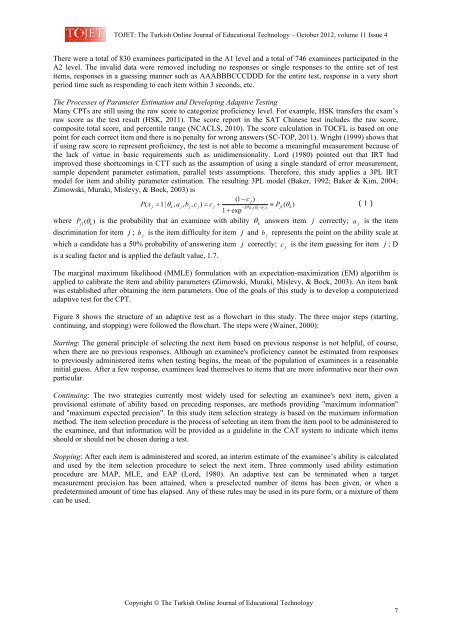october 2012 - TOJET the Turkish online journal of educational ...
october 2012 - TOJET the Turkish online journal of educational ...
october 2012 - TOJET the Turkish online journal of educational ...
Create successful ePaper yourself
Turn your PDF publications into a flip-book with our unique Google optimized e-Paper software.
<strong>TOJET</strong>: The <strong>Turkish</strong> Online Journal <strong>of</strong> Educational Technology – October <strong>2012</strong>, volume 11 Issue 4<br />
There were a total <strong>of</strong> 830 examinees participated in <strong>the</strong> A1 level and a total <strong>of</strong> 746 examinees participated in <strong>the</strong><br />
A2 level. The invalid data were removed including no responses or single responses to <strong>the</strong> entire set <strong>of</strong> test<br />
items, responses in a guessing manner such as AAABBBCCCDDD for <strong>the</strong> entire test, response in a very short<br />
period time such as responding to each item within 3 seconds, etc.<br />
The Processes <strong>of</strong> Parameter Estimation and Developing Adaptive Testing<br />
Many CPTs are still using <strong>the</strong> raw score to categorize pr<strong>of</strong>iciency level. For example, HSK transfers <strong>the</strong> exam’s<br />
raw score as <strong>the</strong> test result (HSK, 2011). The score report in <strong>the</strong> SAT Chinese test includes <strong>the</strong> raw score,<br />
composite total score, and percentile range (NCACLS, 2010). The score calculation in TOCFL is based on one<br />
point for each correct item and <strong>the</strong>re is no penalty for wrong answers (SC-TOP, 2011). Wright (1999) shows that<br />
if using raw score to represent pr<strong>of</strong>iciency, <strong>the</strong> test is not able to become a meaningful measurement because <strong>of</strong><br />
<strong>the</strong> lack <strong>of</strong> virtue in basic requirements such as unidimensionality. Lord (1980) pointed out that IRT had<br />
improved those shortcomings in CTT such as <strong>the</strong> assumption <strong>of</strong> using a single standard <strong>of</strong> error measurement,<br />
sample dependent parameter estimation, parallel tests assumptions. Therefore, this study applies a 3PL IRT<br />
model for item and ability parameter estimation. The resulting 3PL model (Baker, 1992; Baker & Kim, 2004;<br />
Zimowski, Muraki, Mislevy, & Bock, 2003) is<br />
( 1−<br />
c j )<br />
P(<br />
x j = 1|<br />
θk , a j , b j,<br />
c j ) = c j +<br />
≡ P 1(<br />
)<br />
D*<br />
a ( b ) j θ<br />
(1)<br />
−<br />
k<br />
j θk − j<br />
1+<br />
exp<br />
where Pj1( θ k ) is <strong>the</strong> probability that an examinee with ability θ k answers item j correctly; a j is <strong>the</strong> item<br />
discrimination for item j ; j b is <strong>the</strong> item difficulty for item j and b j represents <strong>the</strong> point on <strong>the</strong> ability scale at<br />
which a candidate has a 50% probability <strong>of</strong> answering item j correctly; c j is <strong>the</strong> item guessing for item j ; D<br />
is a scaling factor and is applied <strong>the</strong> default value, 1.7.<br />
The marginal maximum likelihood (MMLE) formulation with an expectation-maximization (EM) algorithm is<br />
applied to calibrate <strong>the</strong> item and ability parameters (Zimowski, Muraki, Mislevy, & Bock, 2003). An item bank<br />
was established after obtaining <strong>the</strong> item parameters. One <strong>of</strong> <strong>the</strong> goals <strong>of</strong> this study is to develop a computerized<br />
adaptive test for <strong>the</strong> CPT.<br />
Figure 8 shows <strong>the</strong> structure <strong>of</strong> an adaptive test as a flowchart in this study. The three major steps (starting,<br />
continuing, and stopping) were followed <strong>the</strong> flowchart. The steps were (Wainer, 2000):<br />
Starting: The general principle <strong>of</strong> selecting <strong>the</strong> next item based on previous response is not helpful, <strong>of</strong> course,<br />
when <strong>the</strong>re are no previous responses. Although an examinee's pr<strong>of</strong>iciency cannot be estimated from responses<br />
to previously administered items when testing begins, <strong>the</strong> mean <strong>of</strong> <strong>the</strong> population <strong>of</strong> examinees is a reasonable<br />
initial guess. After a few response, examinees lead <strong>the</strong>mselves to items that are more informative near <strong>the</strong>ir own<br />
particular.<br />
Continuing: The two strategies currently most widely used for selecting an examinee's next item, given a<br />
provisional estimate <strong>of</strong> ability based on preceding responses, are methods providing "maximum information"<br />
and "maximum expected precision". In this study item selection strategy is based on <strong>the</strong> maximum information<br />
method. The item selection procedure is <strong>the</strong> process <strong>of</strong> selecting an item from <strong>the</strong> item pool to be administered to<br />
<strong>the</strong> examinee, and that information will be provided as a guideline in <strong>the</strong> CAT system to indicate which items<br />
should or should not be chosen during a test.<br />
Stopping: After each item is administered and scored, an interim estimate <strong>of</strong> <strong>the</strong> examinee’s ability is calculated<br />
and used by <strong>the</strong> item selection procedure to select <strong>the</strong> next item. Three commonly used ability estimation<br />
procedure are MAP, MLE, and EAP (Lord, 1980). An adaptive test can be terminated when a target<br />
measurement precision has been attained, when a preselected number <strong>of</strong> items has been given, or when a<br />
predetermined amount <strong>of</strong> time has elapsed. Any <strong>of</strong> <strong>the</strong>se rules may be used in its pure form, or a mixture <strong>of</strong> <strong>the</strong>m<br />
can be used.<br />
Copyright © The <strong>Turkish</strong> Online Journal <strong>of</strong> Educational Technology<br />
7
















